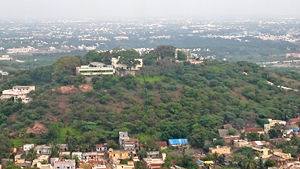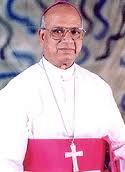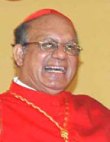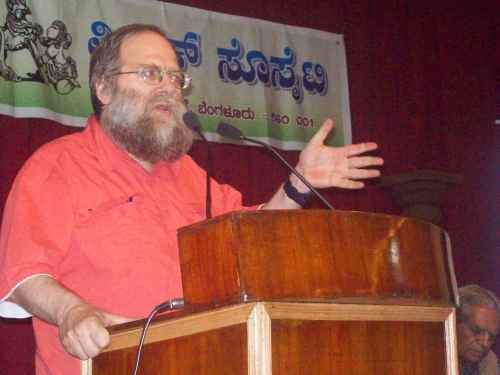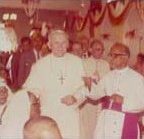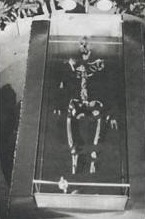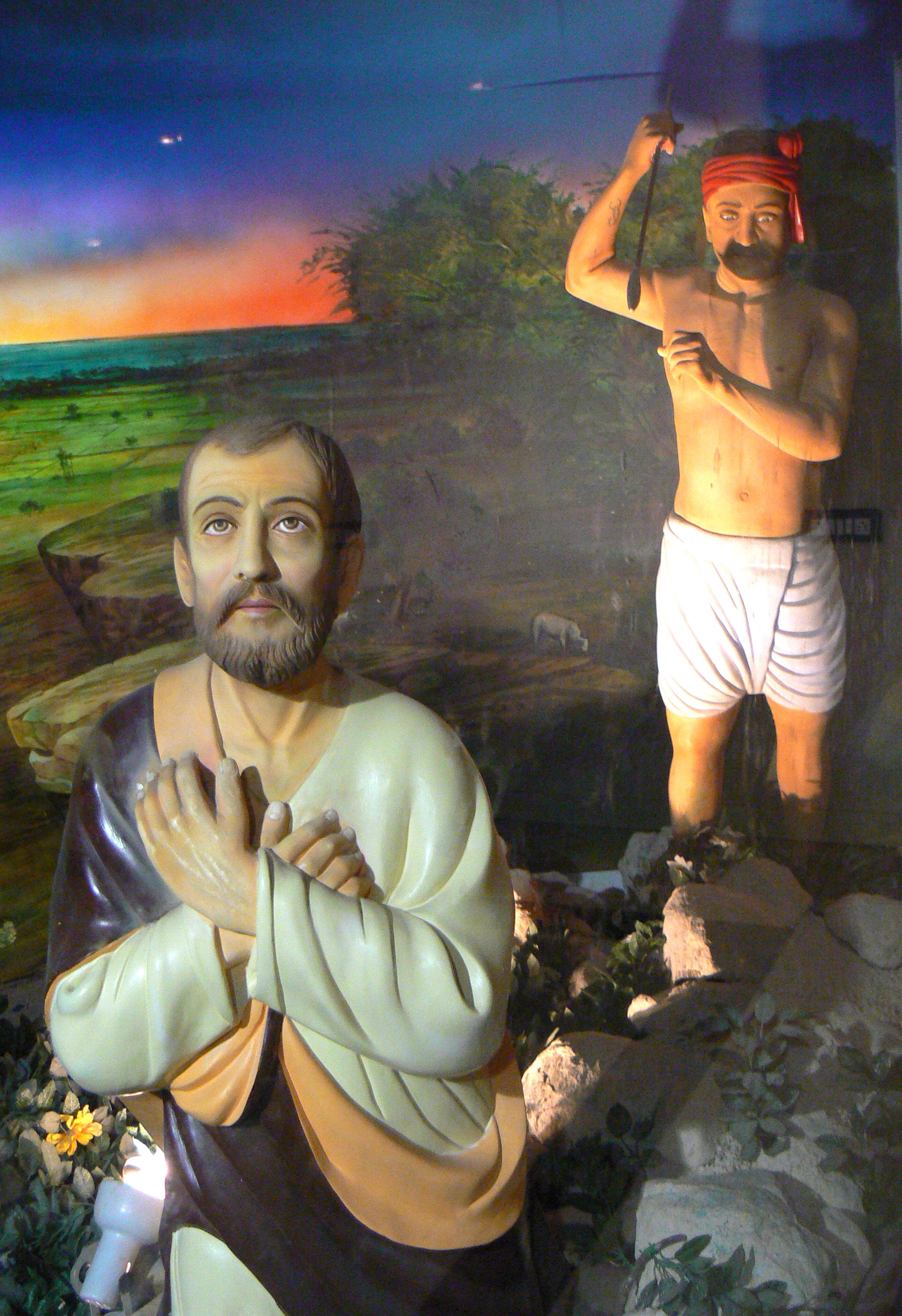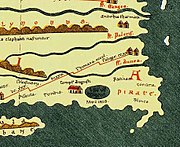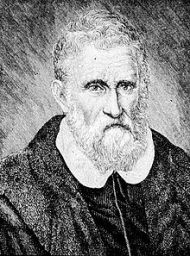The article which follows, published in the Indian Express, Madras, on 30 December 1989, and the refusal of the editor to publish our reply, was the reason we began our research into the St. Thomas in India legend. Had the Indian Express editor Ramanathan allowed us to reply, we would have never bothered to begin our extended research into the legend which has resulted in four editions of our book. — Ishwar Sharan
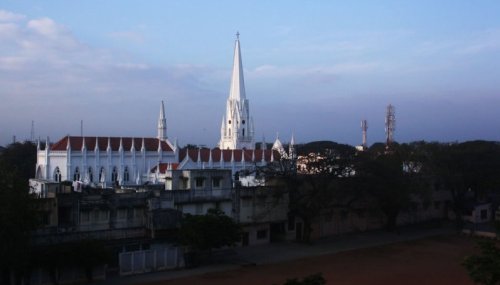
It is difficult to say whether Mylapore found its place in travel notes of many ancient foreign travellers because it had on its soil the tomb of St. Thomas or if the tomb itself was mentioned therein because of its location at Mylapore on the eastern coast. It is a historical fact that many foreign travellers used to visit this coast after sailing a long distance thanks to the Coromandel winds. Marco Polo, the great traveller, has referred to the tomb in his travel diary.
The present Gothic church was constructed over the tomb only in 1893; but it is going to be almost 20 centuries since the first church was constructed by St. Thomas, the father of Christianity in India, before his martyrdom in 73 AD.
The tomb of St. Thomas, one of the twelve Apostles (disciples) of Jesus Christ, attracts people from all over the world. It is a pilgrim centre for Christians, especially during Christmas and Easter seasons. Its history, battles fought over the mortal remains of the saint, burial, excavation, relocation of the tomb, etc., all form part of a high drama the church witnessed over the centuries.
Today Santhome has in its possession only a piece of bone and the metal spearhead with which the saint was assassinated in Madras. These are kept under the safe custody of the priests. It is exposed for public veneration during the annual solemn novena for the feast of St. Thomas on July 3rd every year.
The expression “doubting Thomas” originated after Thomas, disciple of Jesus Christ, who was not ready to believe the resurrection of the Christ when it was narrated to him by other disciples to whom Jesus appeared for the first time after the crucifixion and burial. Thomas declared: “Unless I see in his hands the print of the nails, and place my finger in the mark of the nails, and place my hand in his side, I will not believe.”
According to the Bible, Jesus appeared again inside a closed room where all the disciples were planning their next course of action. Jesus called Thomas and asked him to put his finger on the mark of the wounds. Thomas was taken aback. Thomas felt divine reality encountering human weakness of doubt face to face. He was convinced. He knelt down and uttered: “Thou art my Lord and God”.
Thomas landed at Maliankara (Cranganore in Kerala) in 52 AD with Habban, a foreign trader. He preached the Gospel, wrought miracles and went to Mailepuram (now Mylapore) and then on to China. He returned to Maliankara at the behest of the son-in-law of the Raja of Thiruvanchikulam.
Thomas spent the last part of his life in Madras preaching the Gospel. A large number of people listened and embraced the way of life preached by him. The oppressed and downtrodden followed him and claimed equal status in society as it was denied them by the prevailing social norms. He condemned untouchability and attempted to restore equal status for women.
Many stories are sung as folk songs and have descended to us through the generations. One of them about the origin of the church at Santhome is very interesting.
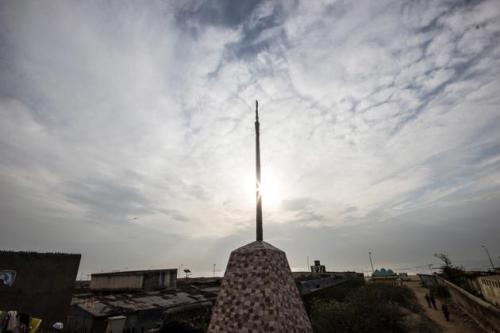
A huge timber log was washed ashore by the waves. In spite of the battery of strong men deployed by King Mahadeva, they could not succeed in bringing it to the shore. As suggested by some of his courtiers, the king summoned the saint. St. Thomas performed another miracle. Pleased by this, the king offered a place near the shore where the timber was first sighted. Thus the old church at Mylapore was built.
As he preached and performed miracles, enemies also grew in number and strength. They vowed to finish him. He had to spend some time in a cave at Little Mount hiding from his enemies. Finally he was killed at what is now known as St. Thomas Mount.
His body was brought to Mylapore, buried and the exact location was forgotten for a long time. Later, in 1523, while digging for laying foundation for a new church they came across signs of the tomb. Immediately the priest in charge of the operation sought the help of higher authorities and then continued excavation.
They removed a lot of earth. After removing two concrete slabs placed between sand and earth they came upon pieces of bones and skull. At the foot there was an earthen vessel supposedly filled with earth taken from the spot where the saint’s blood was shed. They further unearthed a metal spearhead having the shape of an olive leaf and also struck upon a wooden shaft.
The bones and other mortal remains were kept in a box and later buried at an undisclosed location near the church as the priest feared for the safety of the same since the news of possible attack by neighbouring kings were pouring in.
Rivalries among Dutch, French and British wrought devastation on Santhome. The Golconda Sultans attacked and occupied the place for years. In 1646, Mir Jumla, Nawab of Carnatic, also attacked.
Hyder Ali, Sultan of Mysore, besieged Santhome three times during 1769, 1780 and 1782.
Due to several attacks and siege, Santhome church was damaged beyond recognition. In 1893 the new church was constructed. The tall bell-tower is an evidence of Gothic architectural excellence.

The church was made a minor basilica in 1956 by Pope Pius XII. The basilica title is conferred on churches based on its antiquity, magnificence and celebrity. The word basilica means a church with honorific privileges. There are only four major basilica in the whole world. None of them is in India and the most prominent among them is the St. Peter’s at Vatican.
The tomb of great historical importance is inside the church at Santhome near the sanctum sanctorum. It is open to visitors almost during the whole day. The Tourism Development Corporation on its conducted tours makes a stop at the tomb.
A lot of efforts are on to provide better facilities for the tourists visiting the church every day. Fr. Charles, assistant priest, further informed this writer that there may be celebrations on the 3rd of every month, starting from January 1990 onwards, with the help of parishioners.[1]
Postscript
This story, with photographs of Santhome Cathedral Basilica, appeared on 30 December 1989 on the front page of the Express Weekend. It was placed below a feature of Madras city history. No indication was given to show that one article dealt with popular legend and the other with historical fact. They were presented together to commemorate the 350th anniversary of the founding of the British factory north of Mylapore and Triplicane at the fishing village of Madrasapattinam.
On reading the St. Thomas feature, we sent a letter of protest to the Indian Express editor exposing Simon’s story. It was published on 13 January 1990 in the Express Weekend. The paragraphs that were excised by the editor are reproduced here in italics:
Apropos of the article “In Memory of a Slain Saint” (EW, Dec. 30), it is indeed astonishing that the Indian Express allows its respected columns to be used to promote this Catholic romance as historical fact in this age of excellent critical scholarship.[2]
In his book Papacy: Its Doctrine and History (Voice of India, New Delhi, 1986) the historian Sita Ram Goel writes about the St. Thomas myth:
“Some Catholic scholars have been busy for many years marshalling literary and archaeological evidence in an effort to prove that St. Thomas came to India in 52 AD, converted some Hindus in the South, and was killed by Brahmins at Mylapore in Madras while giving the Good News to the local people….
“It would be a waste of time to present the pros and cons of this controversy which tends to become more and more technical. Suffice it to say that some historians have seriously doubted the very existence of an apostle named Thomas. Distinguished scholars like R. Garbe, A. Harnack and L. de la Vallee-Poussin have denied credibility to the Acts of Thomas, an apocryphal work on which the whole story is based. Some others, who accept the fourth century Catholic tradition about the travels of St. Thomas, point to the lack of evidence that he ever went east beyond Ethiopia and Arabia Felix. The confusion, according to them, has arisen because the ancient geographers often mistook these two countries for India.
“The whole subject has been examined recently by Stephen Neill in his History of Christianity in India: The Beginnings to 1707 A.D. published by the Cambridge University Press, England, as late as 1984. He says, ‘A number of scholars, among whom are to be mentioned with respect Bishop A.E. Medlycott, J.N. Farquhar and the Jesuit J. Dahlman, have built on slender foundations what can only be called Thomas romances, such as reflect the vividness of their imaginations rather than the prudence of rigid historical critics.’ Pained by the spread of this spurious history among large sections of Indian Christians, he observes, ‘Millions of Christians in India are certain that the founder of their church was none other than apostle Thomas himself. The historian cannot prove it to them that they are mistaken in their belief. He may feel it right to warn them that historical research cannot pronounce on the matter with a confidence equal to that which they entertain by faith.’ Stephen Neill … was a bishop who had spent long years in India.”
There is also reason to believe that St. Thomas Church stands on the ruins of a Jain Neminathaswami temple and a Hindu Shiva temple which had a Nataraja shrine attached. The epigraphical data for the existence of the Jain temple on this site is recorded in Jain Inscriptions in Tamil Nadu by A. Ekambaranath and C.K. Sivaprakasham (Research Foundation for Jainology, Madras, 1987). The evidence for the existence of the Shiva temple, which may be the original Kapaleeswara Temple on the Mylapore beach that got “eroded” by the “sea”, is compiled in an excellent Tamil-language book called Indiavil Saint Thomas Katukkadai (“The Saint Thomas Myth in India”) by Veda Prakash (RAFR, Madras, 1989). This book is recommended for its wealth of information and is available from RAFR, 57 Poonamallee High Road, Maduravayal, Madras 602102.”
When this letter appeared in the Express Weekend without the last paragraph, which referred to the destroyed temples, we sent a letter of protest on January 16th to the Indian Express resident editor:
Apropos of my letter on St. Thomas and the St. Thomas Church, I must observe that the truncated version published in the Express Weekend of Jan. 13th, which omits all reference to the building of the church, is not acceptable and does not do justice to history.
As a Catholic apologist was given prime space in the Express Weekend on Dec. 30th to tell his version of this controversial story, the Indian Express is obliged to give space to another writer or at least permit an open review of the subject.
The destruction of temples by Muslims has been discussed in the Indian Express by many persons including Arun Shourie, as has the destruction of Jain (and if I remember correctly, Buddhist) temples in Kanchi and Kashmir by certain Hindu kings. The Christians have completely escaped this review though they were the worst perpetrators of these kinds of deeds. This is ironical, for Christian missionaries continue to try to force conversion and destroy village temples in Central India.
The editorial tactic of only permitting Christians to criticize Christians does not wash and indicates a double standard operating in the newspaper. The editors have never hesitated to permit Christians to lecture and criticize Hindus and Muslims when they choose to do so.
The Express Weekend refuses to review Veda Prakash’s Indiavil Saint Thomas Katukkadai (The Saint Thomas Myth in India) or even list it as a book received, though in fact the newspaper has received four copies of it.
When the Pope in Rome can no longer enforce the Index,[3] how is it that the Indian Express can censor our reading material, obstruct free access to information, and suppress discussion of a subject because it is controversial?
In honour of free speech, the very least you can do is give a fair review to this interesting little book on St. Thomas and the legends that surround him and the church at Mylapore.
Veda Prakash’s book was never reviewed by the Indian Express, though the editor acknowledged receipt of a copy and promised to give it his attention.
But our protest did not go unnoticed, and as we had sent out copies of the January 13th letter to various interested people, the excised paragraph would appear in the Indian Express on February 10th in a letter from Swami Jyotirmayananda. His letter was cut too and those lines which offended the editor appear below in italics:
Sri Ishwar Sharan has rightly debunked the so-called historical feature “In Memory of a Slain Saint” (EW, Jan. 13) quoting distinguished historians who have seriously doubted the very existence of an apostle named St. Thomas.
In fact the feature that appeared in EW December 30th is false and misleading and there is a large body of evidence saying that there never was a Thomas at all, never mind that he came to Madras.
There is reason to believe that St. Thomas Church stands on the ruins of a Jain Neminathaswami temple and a Shiva temple which had a Nataraja shrine attached. The epigraphical data for the existence of the Jain temple on this site is recorded in Jain Inscriptions in Tamil Nadu by A. Ekambaranath and C.K. Sivaprakasham (Research Foundation for Jainology, Madras, 1987). The evidence for the existence of the Shiva temple, which may be the original Kapaleeswara Temple on the Mylapore beach that got eroded by the sea,[4] is found in “The Saint Thomas Myth in India” (in Tamil) by Veda Prakash (RAFR, Madras, 1989), who has provided a wealth of information on the subject.
This paragraph―for the non-publication of which we had taken the Indian Express editor to task―contained wrong information about the Kapaleeswara Temple and to make matters worse, the wrong information was attributed to a wrong source. The correct source for the wrong information about the original temple, was the 1985 edition of the TTK A Map’s Guide Book to Madras which says, “A tradition has it that the first temple was by the sea but erosion caused it to be shifted inland.”
The real tradition of course was that the “erosion” of the original Kapaleeswara Temple on the seashore had been caused by Christians. This fact would finally be brought to light in the Express Weekend on March 3rd in a letter from Veda Prakash:
This refers to the letter of Swami Jyotirmayananda published under the caption “Santhome Church” (EW, Feb. 10). Certain details he has mentioned about my book Indiavil Saint Thomas Katukkadai (The Saint Thomas Myth in India) are incorrect as pointed out below.
He writes, “The evidence for the existence of the Shiva temple, which may be the original Kapaleeswara Temple on the Mylapore beach that got eroded by the sea, is found in ‘The Saint Thomas Myth in India’ (in Tamil) by Veda Prakash, (RAFR, Madras, 1989), who has provided a wealth of information on the subject.” But, nowhere in the book do I mention that the Shiva temple on the Mylapore beach was eroded by the sea. What is mentioned about the Shiva temple is as follows: “… many evidences available in Santhome Church show there was a Shiva temple and it was occupied, then step by step demolished and converted into a church. Many documents and books also prove this. A fragmentary Tamil inscription of 8 lines on a stone found at the cathedral registers a tax-free gift for burning at night a lamp before the image of Kuthadumdevar (Nataraja) in the temple of Suramudayar (Suramudayar Kuthadum Devarkku) was found in 1924. It belongs to Vikrama Chola’s time, i.e., 12th century. Moreover, when the urchava murthy was taken for procession from the existing Kapaleeswara Temple, there was a practice of lowering it reverently three times before the Santhome Church at that time (16th-18th centuries). The temple was there up to the 16th century. Then, when the Christians started demolishing it completely, Hindus built the present temple out of whatever they could salvage from the ruins of the old temple.” (P. 41-42, Indiavil Saint Thomas Katukkadai.)
The publisher is not RAFR. Either it should be MMAK (Menattu Mathangal Araychi Kazhagam) or ISWR (Institute for the Study of Western Religions), 57, Poonamallee High Road, Maduravayal, Madras 602102.
This was the third and last letter published in the Express Weekend in reply to C.A. Simon’s article. The letters were not a sufficient or comprehensive reply, but the Indian Express would not tolerate further criticism of the St. Thomas fable in its columns.
1. This article, which appeared in the Indian Express on 30 December 1989, was the reason we began our research into the St. Thomas in India legend.
2. This paragraph was converted by the editor into the prosaic introductory line: “This refers to ‘In Memory of a Slain Saint’ (EW, Dec. 30).”
3. The Vatican’s official list of books Catholics are forbidden to read.
4. The words “eroded” and “sea” should have been in quotation marks.
















